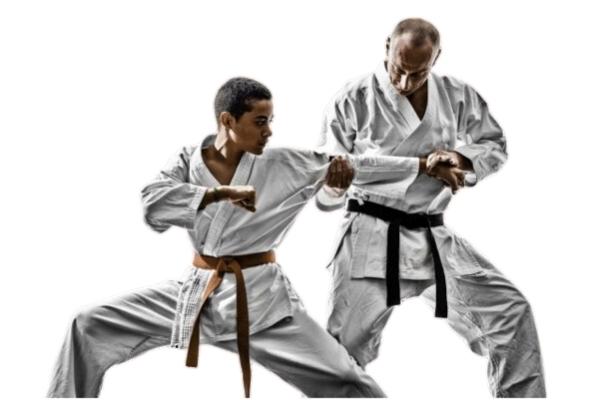In the world of Martial Arts, Shotokan Karate has always faced criticism. However, the criticism is subjective and varies based on individual perspectives. While looking for the benefits of this Martial Art, we also need to explore what is Shotokan Karate and why Shotokan Karate is bad.
To find the answer to this question, let’s dive into the history, styles, training strategies, ranking systems, and all the pros and cons associated with this style of Martial arts.
Shotokan Karate is a dynamic Martial Art founded by Gichin Funakoshi in the early 20th century. This karate style traditional martial art originated in Japan and gained worldwide popularity.
This style of Martial Arts was named Shotokan in honor of Funakoshi. The “Shoto” refers to Funakoshi’s pen name, meaning pine waves which symbolize the strength of nature. On the other hand, “kan” refers to the hall where he used to train his practitioners.
Shotokan focuses on both physical and self-defense techniques. This martial art emphasizes vital techniques, strikes, and powerful stances.
In addition to physical fitness and self-defense training, Shotokan strongly emphasizes discipline and etiquette in the Dojo (Training hall).
Besides its numerous benefits, Shotokan also has a negative side to it. It is a non-contact and rule-based martial art. The practitioners are bound to follow the rules during the encounters, affecting their performance.
Table of Contents
ToggleShotokan Karate Fighting Techniques
Shotokan techniques focus on balanced and precise movements, including solid stances and powerful strikes. The critical fighting techniques used by practitioners are:
Strikes (Tsuki)
It consists of several punching and striking techniques. These arm and knee strikes are used to target the opponent’s body during combat.
Kicks (Geri)
The kicking techniques include front kicks, roundhouse kicks, sidekicks, and back kicks. Kicks are used for both self-defense and combating the opponent.
Blocks (Uke)
The most commonly used blocking techniques in Shotokan Karate are downward blocks, inward blocks, and outward blocks. Blocks are a good strategy for self-defense.
Stances (Dachi)
Shotokan Karate fighting stances are the positions involved in the combat by the practitioners which help in balance and stability of the practitioner. It includes front and back stances and cat stances.
Empowering Self-Defense Skills
The fighting techniques used in Shotokan Karate play a significant role in empowering the practitioners with self-defense skills. The striking and blocking techniques make the practitioners ready for counterattacks in many real-life instances.
The physical fitness training in Shotokan Karate helps enhance endurance and flexibility, thus preparing your body for physical confrontations.
The Shotokan fighting techniques help in maintaining practitioner balance, body coordination, and quick responses during the game, which proves effective in real-life self-defense situations. The distance maintenance rule of this Martial Art also proves effective in self-defense encounters.
Role of Shotokan Karate in Street Fighting
The self-defense techniques taught in Shotokan Karate serve as a backbone in street fighting while preparing you for street fights. The mental focus, speed, coordination, and physical training in Shotokan effectively defend oneself in street fighting scenarios.
Potential Risks in Shotokan Karate
Have you tried to discover why Shotokan Karate is bad for your safety? Although there are various benefits of Shotokan Karate, it also has some risks associated with its practice. According to some Martial Arts experts, here are a few reasons why Shotokan Karate is a bad choice.
Risk of Injuries
● Being a contact sport, If not practiced correctly, Shotokan Karate will lead to several severe injuries, sprains, bruises, and even fractures.
● The joint and muscle strain due to the dynamic and physically demanding nature of this Martial Art is another reason why Shotokan Karate is bad in the opinion of critics.
Risk of Falls
According to the critics, one of the many reasons why Shotokan Karate is bad is the risk of falls due to the stances, involuntary movements, and footwork involved.
Unrealistic Approach
It is more of a Traditional Martial Art and follows a set of rules, while in real-life fighting scenarios, you cannot be an effective opponent if you follow the training rules. That is why Shotokan karate is bad in real-life fighting scenarios.
Ranks and Levels
The table shows beginner-level colored ranking belt order.
| Rank | Belt Color |
| 9th Kyū | White |
| 8th Kyū | Yellow |
| 7th Kyū | Orange |
| 6th Kyū | Green |
| 5th Kyū | Purple |
| 4th Kyū | Purple and white |
| 3rd Kyū | Brown |
| 2nd Kyū | Brown |
| 1st Kyū | Brown and white |
Dan Ranking System
Advanced level Dan ranks start from 1st Dan and continue till 10th Dan, the highest achievement level in Shotokan Karate.
Shotokan Karate Belt Requirements
Shotokan Karate belt requirements vary depending on the training organization. The beginner-level colored belts need the practitioner to have the basic training of the punches, strikes, blocks, kicks, and footwork.
On the other hand, the practitioner needs to be more expert in these techniques while learning additional skills like kata and sparring strategies to achieve higher ranks.
While moving towards the higher ranks, the list of expertise required during the game also increases. The practitioner must have a good command of the Shotokan techniques, better coordination, and time management to move up to the higher belt levels.
Conclusion
So we can conclude that Shotokan Karate, like other Martial Arts, has positive and negative aspects. One aspect shows that its training helps real-world self-defense scenarios.
On the other hand, some critics say that it follows an unrealistic approach as the rules of the game stop you from involuntary responses during the game. The debate about the strengths and weaknesses of Shotokan is subjective and depends upon your personal goals and preferences.
Frequently Asked Questions
Is Shotokan Karate good for street fighting?
The self-defense techniques taught in Shotokan Karate serve as a backbone in street fighting while preparing you for street fights. The mental focus, speed, coordination, and physical training in Shotokan effectively defend oneself in street fighting scenarios.
How is Shotokan Karate good for self-defense?
The fighting techniques used in Shotokan Karate play a significant role in empowering the practitioners with self-defense skills.
Is Shotokan Karate dangerous?
Although Shotokan Karate empowers practitioners with strength, coordination, and self-defense skills it is also dangerous because of the risks of falls, injuries, and fractures if not practiced properly.
Why Shotokan Karate is bad, according to some critics?
According to critics, the fighting stances in Shotokan Karate are not safe. The position of the hands and legs exposes the entire body to attack.

